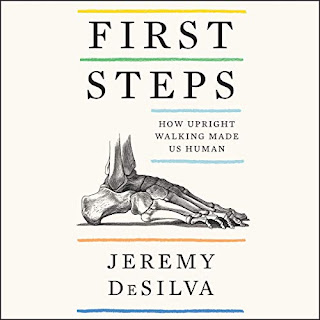Jeremy DeSilva gives us a fascinating look at the early evolution of humans, from the, to me, unfamiliar perspective of the human foot and why we walk upright. It's an account that's conversational, clear, empathetic to both early hominins and to fellow researchers, past and present, and careful to present good scientific information, the prevailing understanding of it or his view of it, as well as competing views, with the evidence that supports the competing views. It's fair to say he's not overburdened with ego, and he has a good sense of humor.
DeSilva specializes in the hominin foot and ankle, and this is unexpectedly fascinating. The human foot, and the feet of our ancestors back to Australopithecus, is very odd compared to most primates. No other primate, indeed no other mammal, walks upright on two feet. It's a more precarious way to walk, with balance more of a challenge. It's more prone to injury, and biped with one leg out of commission, unlike a quadruped, loses mobility and becomes easy prey. For much of the last six million years, the planet was filled with predators for which our early ancestors would have been a tasty meal. Why did our ancestors set out on the road of becoming so vulnerable? What advantages were there?
I grew up being taught that early proto-humans walked out into the widening savannah, and discovered the advantages of standing up on their hind legs to see both food and predators at greater distances. As they evolved to become more adapted to bipedal locomotion, they could make better use of tools, and we were on our way to world domination.
But now newer evidence suggests we became upright while still among the trees. A life divided between the trees and the ground opened a niche for a species that could gather and carry food more easily, possibly to share with mates, offspring, or other group members. This may have been the last common ancestor for us and chimpanzees and bonobos--which then raises the question of why they gave that up to become knuckle-walkers. We don't know for sure that's what happened, but it's what the evidence suggests now.
Oue early human ancestors emerged onto the savannah already upright, accustomed to carrying things, and able to see what was happening at a greater distance than quadrupeds.
We get an interesting overview of the early human species, including the growing number we know to have been contemporary with early homo sapiens. Some of them, certainly Neanderthals and Denisovans, and possibly others, we interbred with. Others, we may have wiped out. There's more than I can do justice to in a review.
It seems that walking upright did more than give us access to the savannah and the ability to make and carry tools. It also gave us the breath control that makes complex speech physically possible.
In addition to the hard science and the interesting and complex process of how we make paleoanthropological discoveries and work out what they mean, DeSilva goes on to the equally fascinating subject of how this evolutionary history interacts with how we live now. This includes the unexpected importance of just getting out and walking for our physical and mental health.
There's much to learn here, and it's a very enjoyable listen. Highly recommended.
I bought this audiobook.

No comments:
Post a Comment